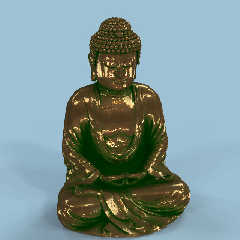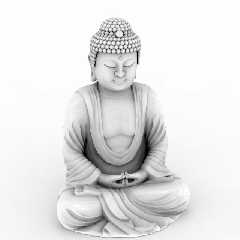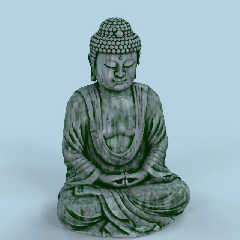 |
 |
|
 |
|
 |
|  |
|  |
|
 |
|
 |
|  |
|  |
|
 |
A simple test to simulates a type of corrosion.
The render uses an ambient occlusion image as the pattern that in turn
chooses between bronze or corrosion (modified by a mild slope pattern,
and a bit of randomness supplied by bozo).
Looking at some real bronze statue photographs on the interwebs, I
reckon I'm a long, long way from getting real corroded bronze, but at
least the general direction looks promising...
The second image is the ambient occlusion pass.
Cheers,
Edouard.
Post a reply to this message
Attachments:
Download 'ao-test.jpg' (95 KB)
Download 'ao-map.jpg' (49 KB)
Preview of image 'ao-test.jpg'

Preview of image 'ao-map.jpg'

|
 |
|  |
|  |
|
 |
|
 |
|  |
|  |
|
 |
Edouard Poor wrote:
> A simple test to simulates a type of corrosion.
>
> The render uses an ambient occlusion image as the pattern that in turn
> chooses between bronze or corrosion (modified by a mild slope pattern,
> and a bit of randomness supplied by bozo).
>
> Looking at some real bronze statue photographs on the interwebs, I
> reckon I'm a long, long way from getting real corroded bronze, but at
> least the general direction looks promising...
>
> The second image is the ambient occlusion pass.
>
> Cheers,
> Edouard.
And another one, this time I tried a high-pass filter on the ambient
occlusion image before using it in the image to localise the placement
of the corrosion/dirt/mold. I think the effect is a bit better for it.
What do you think?
Cheers,
Edouard.
Post a reply to this message
Attachments:
Download 'ao-test-3.jpg' (112 KB)
Preview of image 'ao-test-3.jpg'

|
 |
|  |
|  |
|
 |
|
 |
|  |
|  |
|
 |
48c1017b@news.povray.org...
> And another one, this time I tried a high-pass filter on the ambient
> occlusion image before using it in the image to localise the placement
> of the corrosion/dirt/mold. I think the effect is a bit better for it.
>
> What do you think?
>
> Cheers,
> Edouard.
>
I agree it's better (maybe due to textures as well as process on the
occlusion image.
I see more moss than corrosion though :-)
Marc
Post a reply to this message
|
 |
|  |
|  |
|
 |
|
 |
|  |
|  |
|
 |
m_a_r_c wrote:
> I agree it's better (maybe due to textures as well as process on the
> occlusion image.
> I see more moss than corrosion though :-)
Heh - that's why I changed the statue to cheesy marble - it looked more
like moss or something else organic to me too.
> Marc
Cheers,
Edouard.
Post a reply to this message
|
 |
|  |
|  |
|
 |
|
 |
|  |
|  |
|
 |
This one looks good indeed!
The metal in the previous image seems too shiny to me, in combination with
the corrosion. You could try to tarnish it some more. Maybe the corrosion
should be a paler greenish tint?
Thomas
Post a reply to this message
|
 |
|  |
|  |
|
 |
|
 |
|  |
|  |
|
 |
Edouard Poor <pov### [at] edouard info> wrote:
> What do you think?
I think you are on the right track! This last image looks good, but not like
bronze, IMO. More like turquoise. This could be due to my monitor's gamma
setting, though. How are you applying the image? Rune's illusion.inc?
Dirt-mapping is something I always go back to. Lately I've found that Blender
can produce good UV maps that you can burn ambient occlusion onto.
Keep up the good work. I look forward to seeing more interesting images from you
:)
Sam info> wrote:
> What do you think?
I think you are on the right track! This last image looks good, but not like
bronze, IMO. More like turquoise. This could be due to my monitor's gamma
setting, though. How are you applying the image? Rune's illusion.inc?
Dirt-mapping is something I always go back to. Lately I've found that Blender
can produce good UV maps that you can burn ambient occlusion onto.
Keep up the good work. I look forward to seeing more interesting images from you
:)
Sam
Post a reply to this message
|
 |
|  |
|  |
|
 |
|
 |
|  |
|  |
|
 |
Samuel Benge wrote:
> Edouard Poor <pov### [at] edouard info> wrote:
>> What do you think?
>
> I think you are on the right track! This last image looks good, but not like
> bronze, IMO. More like turquoise. This could be due to my monitor's gamma
> setting, though. How are you applying the image? Rune's illusion.inc?
Since the first one looked so little like bronze with corrosion, I tried
more of a stone with mold look for the second one.
I'm applying the image with Rune's illusion.inc - I only started using
that a week or so ago, and there's so much that you can do with it! I
tried to do the mapping myself, but failed badly - luckily there are
plenty of people out there who are much better with maths than me...
Hmmm, just had a thought - I wonder if you can do this trick in a single
pass using the camera_view pigment in Megapov? Divide the universe into
the same scene twice, one with AO and one with final lighting, then
camera_view + illusion.inc's maths to pull the AO data into a
pigment_pattern? Sounds both doable, and far trickier than I could
possibly pull off. :-)
> Dirt-mapping is something I always go back to. Lately I've found that Blender
> can produce good UV maps that you can burn ambient occlusion onto.
I downloaded Blender the other day. I'm frankly a little lost in it - I
need to find some good tutorials or similar...
> Keep up the good work. I look forward to seeing more interesting images from you
> :)
Thank-you very much!
I'm still trying to get my head around your proximity and related SSS
macros. Applying the AO image works nicely for some scenes, but your
proximity macro is a global solution, and not just a camera specific one.
> Sam
Cheers,
Edouard. info> wrote:
>> What do you think?
>
> I think you are on the right track! This last image looks good, but not like
> bronze, IMO. More like turquoise. This could be due to my monitor's gamma
> setting, though. How are you applying the image? Rune's illusion.inc?
Since the first one looked so little like bronze with corrosion, I tried
more of a stone with mold look for the second one.
I'm applying the image with Rune's illusion.inc - I only started using
that a week or so ago, and there's so much that you can do with it! I
tried to do the mapping myself, but failed badly - luckily there are
plenty of people out there who are much better with maths than me...
Hmmm, just had a thought - I wonder if you can do this trick in a single
pass using the camera_view pigment in Megapov? Divide the universe into
the same scene twice, one with AO and one with final lighting, then
camera_view + illusion.inc's maths to pull the AO data into a
pigment_pattern? Sounds both doable, and far trickier than I could
possibly pull off. :-)
> Dirt-mapping is something I always go back to. Lately I've found that Blender
> can produce good UV maps that you can burn ambient occlusion onto.
I downloaded Blender the other day. I'm frankly a little lost in it - I
need to find some good tutorials or similar...
> Keep up the good work. I look forward to seeing more interesting images from you
> :)
Thank-you very much!
I'm still trying to get my head around your proximity and related SSS
macros. Applying the AO image works nicely for some scenes, but your
proximity macro is a global solution, and not just a camera specific one.
> Sam
Cheers,
Edouard.
Post a reply to this message
|
 |
|  |
|  |
|
 |
|
 |
|  |
|  |
|
 |
Edouard Poor <pov### [at] edouard info> wrote:
> I downloaded Blender the other day. I'm frankly a little lost in it - I
> need to find some good tutorials or similar...
I sympathise. If you just want ambient occlusion baking then maybe it's worth
looking at xnormal (http://www.xnormal.net/2.aspx). Either way, baking the
occlusion effect into texture maps is likely to be the most efficient solution
for all-mesh scenes (if you're lucky enough to have them).
Tom info> wrote:
> I downloaded Blender the other day. I'm frankly a little lost in it - I
> need to find some good tutorials or similar...
I sympathise. If you just want ambient occlusion baking then maybe it's worth
looking at xnormal (http://www.xnormal.net/2.aspx). Either way, baking the
occlusion effect into texture maps is likely to be the most efficient solution
for all-mesh scenes (if you're lucky enough to have them).
Tom
Post a reply to this message
|
 |
|  |
|  |
|
 |
|
 |
|  |
|  |
|
 |
Edouard Poor wrote:
> I'm applying the image with Rune's illusion.inc - I only started using
> that a week or so ago, and there's so much that you can do with it! I
> tried to do the mapping myself, but failed badly - luckily there are
> plenty of people out there who are much better with maths than me...
Rune's illusion.inc is *very* useful! I wonder if he knew how it would
be used when he made it? I too tried to map an image to the viewing
area, but failed miserably. Thank goodness he figured it out for us ;)
He should get some sort of award for that file!
> Hmmm, just had a thought - I wonder if you can do this trick in a single
> pass using the camera_view pigment in Megapov? Divide the universe into
> the same scene twice, one with AO and one with final lighting, then
> camera_view + illusion.inc's maths to pull the AO data into a
> pigment_pattern? Sounds both doable, and far trickier than I could
> possibly pull off. :-)
The camera pigment takes render options from the whole scene file. I
suppose you could place a copy of the mesh in an ambient cube with
radiosity applied, but you would have to use radiosity for the final
image. But with MegaPOV, can't you turn radiosity off for certain
objects? If so, you can probably do it without having to use radiosity
for the final output.
> I downloaded Blender the other day. I'm frankly a little lost in it - I
> need to find some good tutorials or similar...
I recommend that you don't give up on learning Blender. While looking at
tutorials, keep your eye on the keyboard shortcuts, as they make the
program much easier to use.
> I'm still trying to get my head around your proximity and related SSS
> macros. Applying the AO image works nicely for some scenes, but your
> proximity macro is a global solution, and not just a camera specific one.
But you can't use the proximity macro for mesh objects :( If POV
supported calling inside() for mesh objects, it would work. I wish
somebody would figure out a way to get inside() working with meshes!
Sam
Post a reply to this message
|
 |
|  |
|  |
|
 |
|
 |
|  |
|  |
|
 |
stbenge wrote:
> But you can't use the proximity macro for mesh objects :( If POV
> supported calling inside() for mesh objects, it would work. I wish
> somebody would figure out a way to get inside() working with meshes!
You can make solid meshes now, which *should* work with inside().
Define a mesh using the inside_vector modifier, and see if that works.
--
William Tracy
afi### [at] gmail com -- wtr### [at] calpoly com -- wtr### [at] calpoly edu
"Given a signal with a 2-Hz bandwagon, the Nyquil frequency must be 1-Hz
to avoid aliening of the furrier transformer."
-- phdcomics.com edu
"Given a signal with a 2-Hz bandwagon, the Nyquil frequency must be 1-Hz
to avoid aliening of the furrier transformer."
-- phdcomics.com
Post a reply to this message
|
 |
|  |
|  |
|
 |
|
 |
|  |




![]()